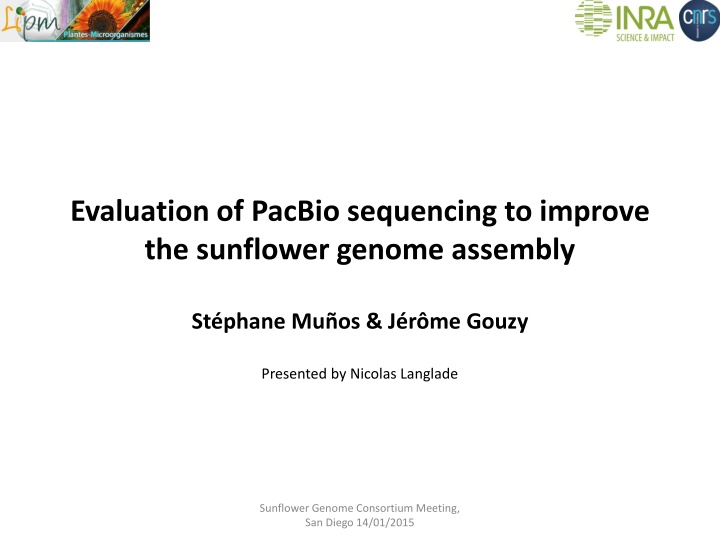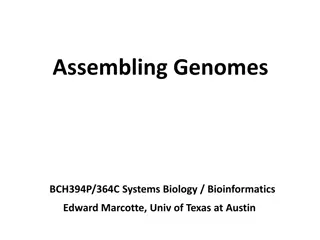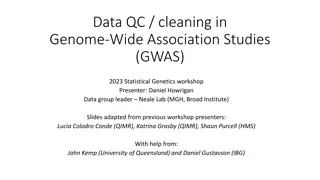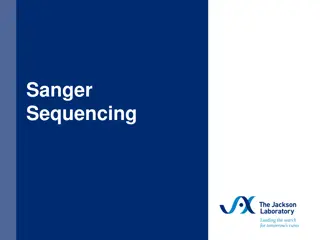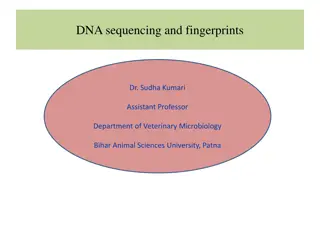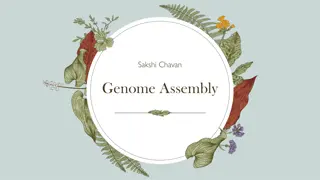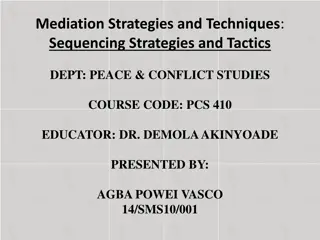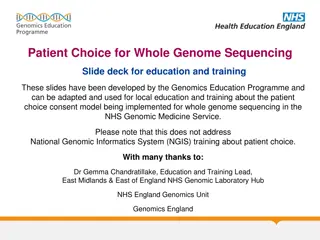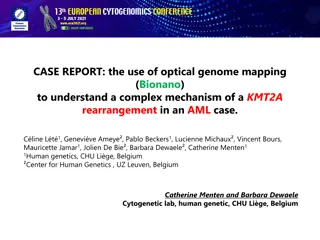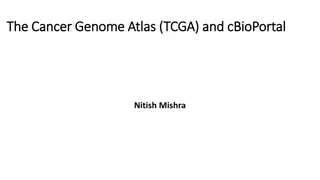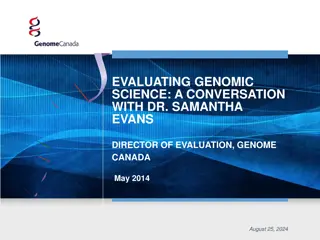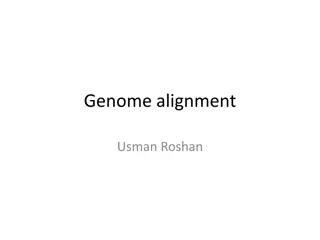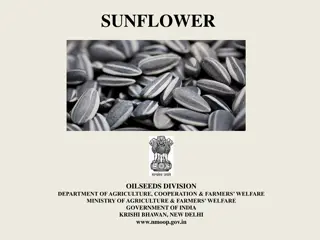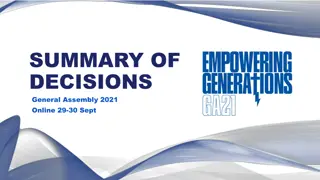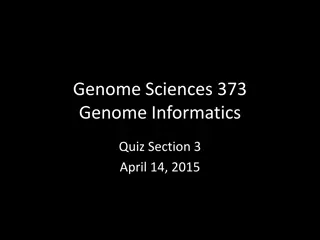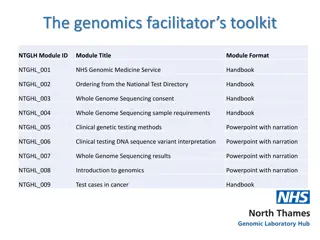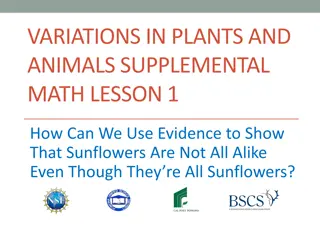Evaluation of PacBio Sequencing to Improve Sunflower Genome Assembly
Presentation at the Sunflower Genome Consortium Meeting in San Diego discussed the use of PacBio sequencing to enhance the sunflower genome assembly, with evaluations on PacBio data's effectiveness at locus and genome scales. Results highlighted challenges and successes in improving assembly quality using PacBio technology.
Download Presentation

Please find below an Image/Link to download the presentation.
The content on the website is provided AS IS for your information and personal use only. It may not be sold, licensed, or shared on other websites without obtaining consent from the author.If you encounter any issues during the download, it is possible that the publisher has removed the file from their server.
You are allowed to download the files provided on this website for personal or commercial use, subject to the condition that they are used lawfully. All files are the property of their respective owners.
The content on the website is provided AS IS for your information and personal use only. It may not be sold, licensed, or shared on other websites without obtaining consent from the author.
E N D
Presentation Transcript
Evaluation of PacBio sequencing to improve the sunflower genome assembly St phane Mu os & J r me Gouzy Presented by Nicolas Langlade Sunflower Genome Consortium Meeting, San Diego 14/01/2015
Recent experiences with PacBio data at a locus scale level (Sunflower) at a genome scale level (fungus) Sunflower Genome Consortium Meeting, San Diego 14/01/2015 Confidential, for internal communication only
Map based cloning of a downy mildew resistance locus St phane Mu os QRM1 in a 0.4cM window, partially covered by a contig of 6 BAC clones Sunflower Genome Consortium Meeting, San Diego 14/01/2015 Confidential, for internal communication only
Results using Roche 454 MP BAC-6 (147.1kb) 2 scaffolds, 12 contigs (9+3). NUM 2 MIN 21016 MAX 110513 N50 BP 110513 N50 NUM 1 MEAN 65764.50 MEDIAN 21016 BP 131529 (2.1% N) BAC-1 (160.3kb) 2 scaffolds, 11 contigs (5+6). NUM 2 MIN 73144 MAX 76146 N50 BP 76146 N50 NUM 1 MEAN 74645.00 MEDIAN 73144 BP 149290 (3.5% N) (coverage : ~87%) (coverage : ~90%) ~ 15kb of missing sequences ~ 19kb of missing sequences At least 10% of missing sequences at a BAC clone level Very very hard to assemble Sunflower even at a micro scale Sunflower Genome Consortium Meeting, San Diego 14/01/2015 Confidential, for internal communication only
PacBio assembly (CNRGV data and assembly) NUM 63,068 MIN 500 MAX 30,506 MEAN 5,738 MEDIAN 4,804 BP 361,884,184 PacBio assembly pipeline A single 740kb contig for the 6 BAC clones, no N !!! Sunflower Genome Consortium Meeting, San Diego 14/01/2015 Confidential, for internal communication only
PacBio assembly evaluation 1) Do we find the correct size of the BACs in the assembly? BAC insert sizes: alignments of Sanger BAC end sequences vs agarose gel estimation BAC BLAST AGAROSE BAC6 147.1 150 Highly consistent assembly BAC1 160.3 160 BAC2 123.5 118 BAC3 196.5 190 BAC4 194.1 190 BAC5 150.5 146 Sunflower Genome Consortium Meeting, San Diego 14/01/2015 Confidential, for internal communication only
PacBio assembly evaluation 2) Do we find back the Illumina sequence tags of the BACs? In silico digested tags vs keygene Illumina FPC tags (100% identity over 100%length) BAC1: 38/38 BAC2: 19/20 BAC3: 27/28 BAC4: 42/44 BAC5: 32/36 BAC6: 37/40 95% of the FPC tags High quality of the sequence Sunflower Genome Consortium Meeting, San Diego 14/01/2015 Confidential, for internal communication only
Evaluation of the repeats at a micro-scale level BAC6-scaffold 1 BAC6-scaffold 2 454 sequencing BAC1-scaffold 1 BAC1-scaffold 2 PacBio-contig PacBio reads NUM 63068 MIN 500 MAX 30506 MEAN 5738 MEDIAN 4804 A lot of repeated sequences with high identity Long PacBio reads span the sunflower repeats Sunflower Genome Consortium Meeting, San Diego 14/01/2015 Confidential, for internal communication only
Repeats analysis of the PacBio contig Impressive number of repeats INSIDE the contig Only 1/3 covered Sunflower Genome Consortium Meeting, San Diego 14/01/2015 Confidential, for internal communication only
Comparison with the bronze assembly In terms of nucleotides without N the bronze assembly corresponds to 1/3 of the PacBio contig Based on primary analyses, the bronze assembly seems to be good at the macro level but still fragmentary at the micro level Sunflower Genome Consortium Meeting, San Diego 14/01/2015 Confidential, for internal communication only
Fungus genome J r me Gouzy Comparison of the sequencing techniques for de novo genome assembly 20X 454 PacBio Illumina paired-end 1000x, mate pair 3, 8 et 20 kb NUM 25 MIN 21845 MAX 4 060 456 N50 BP 1 739 955 N50 NUM 6 MEAN 1 194 760 MEDIAN 1 059 621 BP 29 869 023 % N 0% NUM 401 NUM 550 MIN 1 000 MAX 867 920 N50 BP 194 032 N50 NUM 41 MEAN 46 651 MEDIAN 3 777 BP 25 658 516 %N 3.7% MIN 1 001 MAX 1 358 271 N50 BP 313 520 N50 NUM 25 MEAN 68 987 MEDIAN 14 860 BP 27 663 995 %N 5% Bioinfo: one day ! Bioinfo: several months Sunflower Genome Consortium Meeting, San Diego 14/01/2015 Confidential, for internal communication only
Repeats in the fungus genome Long reads can solve the assembly of very very cryptic chromosomes Pacbio chemistry early 2014 P5/C3 NUM 658 501 MIN 50 MAX 33 585 MEAN 7 925 <<<<< MEDIAN 7 213 BP 5,2Gb (~150x) Sunflower Genome Consortium Meeting, San Diego 14/01/2015 Confidential, for internal communication only
Proposal: sequence the full sunflower genome using Pacbio Lastest chemistry better than the ones we tested (~14kb vs 8kb) 360 Gb to sequence = target 100X coverage 700Mb / SMRT cell 515 SMRT Cell Quote in progress 6months of ~full time of the machine throughput Sunflower Genome Consortium Meeting, San Diego 14/01/2015 Confidential, for internal communication only
Next Steps (2015) 1) The SUNRISE project will dedicate part of the genomic resources WP budget (leader S. Mu os) 2) Organization of the sequencing with the latest chemistry on at least 2 platforms 3) Evaluate the need to integrate previous data in the assembly process 4) Evaluate the need of optical mapping (cost/density) Sunflower Genome Consortium Meeting, San Diego 14/01/2015 Confidential, for internal communication only
Next Steps (2016) 5) Annotation of the PacBio assembly 6) Development of the web portal for the PacBio assembly 7) Integration of the different type of data (Expression, SNPs ) 8) Any suggestion!!! Sunflower Genome Consortium Meeting, San Diego 14/01/2015 Confidential, for internal communication only
